him to use another avenue of
approach.
Table 5-1. Obstacle effects.
(2) Protective Obstacles. SBCT infantry rifle companies are responsible for planning and constructing their own protective obstacles. To be most effective, these should be tied into existing or tactical reinforcing obstacles. The company may use mines and wire from its basic load or receive additional materiel (including MOPMS, if available) from the battalion Class IV or V supply point. The company also may be responsible for any other required coordination (such as that needed in a relief in place), for recovery of the obstacle or for its destruction (as in the case of MOPMS).
(a) In planning for protective obstacles, the commander must evaluate the potential threat to the company's position and then employ the appropriate system to counter that threat. For example, MOPMS is predominantly an antitank system best used on mounted avenues of approach, but it does have some antipersonnel applications. Wire obstacles, on the other hand, may be most effective when employed on dismounted avenues. FM
90-7 provides detailed planning guidance for protective obstacle emplacement.
(b) Protective obstacles are usually located beyond hand grenade distance (40 to 100
meters) from the soldier's fighting position, and may extend out 300 to 500 meters to tie into tactical obstacles and existing restricted terrain. As with tactical obstacles, the
5-11
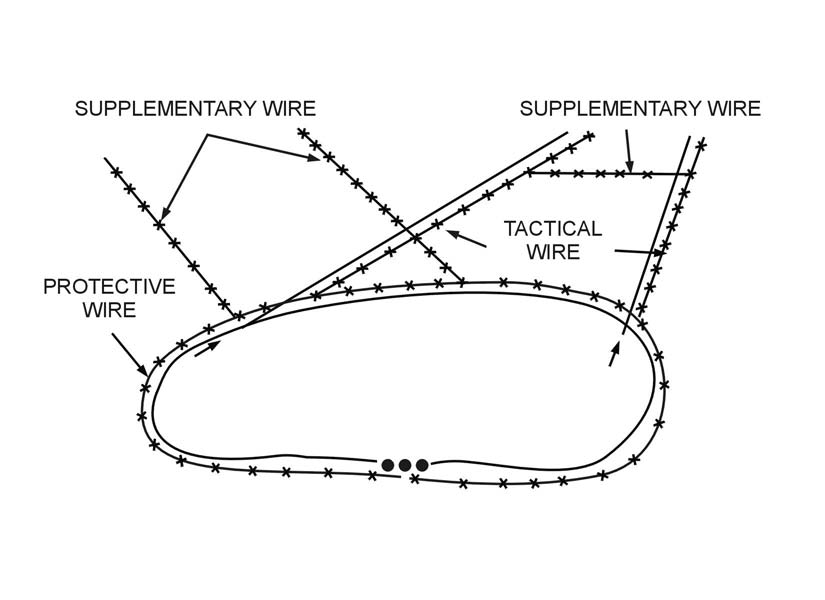
FM 3-21.11
commander should plan protective obstacles in depth and attempt to maximize the effective range of his weapons.
(c) When planning protective obstacles, the company commander should consider the amount of time required to prepare them, the burden on the logistical system, the soldiers'
loads, and the risk of the enemy detecting the obstacles and the resulting loss of surprise.
(3) Wire Obstacles. There are three types of wire obstacles (Figure 5-1): protective wire, tactical wire, and supplementary wire.
(a) Protective wire may be a complex obstacle providing all-round protection of a platoon perimeter, or it may be a simple wire obstacle on the likely dismounted avenue of approach (AA) into a squad ambush position. Command-detonated M18 Claymore mines may be integrated into the protective wire or used separately.
(b) Tactical wire is positioned to increase the effectiveness of the company's fires. It usually is positioned along the friendly side of the machine gun final protective lines (FPLs). Tactical minefields also may be integrated into these wire obstacles or may be used separately.
(c) Supplementary wire obstacles are used to break up the line of tactical wire to prevent the enemy from locating friendly weapons (particularly the machine guns) by following the tactical wire.
Figure 5-1. Protective wire obstacles.
(4) Obstacle Lanes. The company may be responsible for actions related to lanes through obstacles. These duties may include marking lanes in an obstacle, reporting locations of the start and end points of each lane, manning contact points, providing guides for elements passing through the obstacle, and closing the lane.
5-12
FM 3-21.11
5-18. COMBAT SERVICE SUPPORT
In addition to the CSS functions required for all operations (Chapter 11), the SBCT
infantry rifle company commander’s planning process should include the considerations highlighted in the following paragraphs.
a. Pre-Positioning and Caches. The commander’s mission analysis may reveal that the company’s ammunition needs during an upcoming operation exceed its basic load.
This requires the company to pre-position ammunition caches. The caches, which may be positioned either at an alternate or subsequent BP or with the ICVs and MGSs, should be both dug in and guarded.
b. Position of Train. . The company trains normally operate one terrain feature to the rear of the company to provide immediate recovery and medical support. The commander also must ensure that all elements know the locations of the SBCT battalion's combat trains and main aid stations and that they plan and rehearse casualty evacuation procedures.
Section V. PREPARATION AND INTEGRATION
The company commander's analysis determines the most effective measures for every mission. This section describes the techniques and planning considerations available to the company commander as he prepares his defense.
5-19. DEFENSIVE
TECHNIQUES
The company normally defends using one of these basic defensive techniques:
• Defend in sector.
• Defend a BP.
• Defend a strongpoint.
• Defend a perimeter.
• Defend in a linear defense.
• Defend in a nonlinear defense.
• Defend on a reverse slope.
The control measures for the defense are sectors, battle positions, or a combination of these measures. There are no set criteria for selecting the control measures, but Table 5-2, page 5-14, provides some basic considerations.
5-13
FM 3-21.11
BATTLE POSITION
SECTOR
WELL-DEFENDED;
ENEMY CAN BE
AVENUES OF APPROACH
NOT EASILY DEFINED
CANALIZED
DOMINATES
DOMINATING TERRAIN
AVENUES OF
TERRAIN
NOT AVAILABLE
APPROACH
UNIT AREA OF
NARROW/SMALL
WIDE/LARGE
OPERATIONS
CANNOT EASILY BE
ACHIEVABLE MUTUAL
SUPPORT
ACHIEVED
COMMANDERS' ABILITY
GOOD
DEGRADED
TO SEE/CONTROL
RETAIN, BLOCK
ASSIGNED TASK
DISRUPT, CONTAIN
Table 5-2. Selecting control measures.
5-20. SECTOR
DEFENSE
A sector is the company control measure that provides the most freedom of action to a platoon. It provides the platoon with the flexibility to operate in a decentralized manner while still ensuring sufficient control exists to prevent confusion and to synchronize the company's operation. In restricted terrain, where dismounted infantry forces prefer to work, it is difficult to achieve mutual support between the company's platoon battle positions. It is also very difficult for the commander to see and control the fight throughout the company sector.
a. Company Disposition. The company disposition may consist of platoon sectors, a series of mutually supporting BPs on restricted terrain, or a combination of the two (Figure 5-2). Positions are arrayed in depth. The strength of the sector comes from its flexibility. This defense normally orients on the enemy force and not on retaining terrain.
It is effective because it allows the enemy to expose his flanks and critical C2 and CS
assets through his own maneuver into the depth of the defense.
5-14
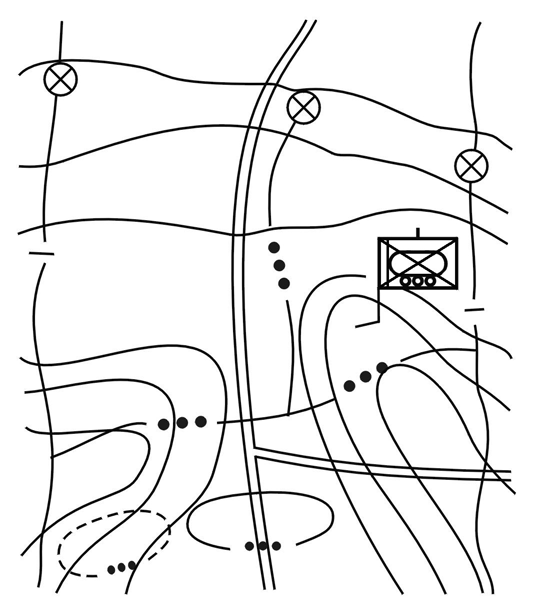
FM 3-21.11
Figure 5-2. Company defense in sector, with a platoon in a BP.
b. Decentralization. By assigning platoon sectors, the company may fight a defense in sector very similar to a nonlinear defense. This decentralized technique for conducting a defense in sector requires greater initiative and delegates more of the control to subordinate leaders. The small-unit actions are very similar to the nonlinear defense.
When required, squads or platoons may disengage independently and move to another location within the sector to continue the fight. Considerations for the company R&S plan and employment of a reserve also are very similar to the nonlinear defense.
c. Platoon Battle Positions. When fighting a company defense in sector from platoon battle positions, the concept is to defeat the attacker through the depth of his formation by confronting him with effective fires from mutually supporting BPs as he attempts to maneuver around them. Infantry positions, patrols, mines, and other obstacles cover gaps that, due to terrain masking or heavy woods, cannot be covered effectively by direct fire. Units remain in place except for local or internal movement to alternate or supplementary positions. If certain platoon positions become untenable during the battle, the company commander may withdraw the platoons according to prepared plans.
(1) One technique is to allow the enemy to move into the EA and destroy him with massed fires. Another technique is to engage the attacker at maximum range with fires from tactical aircraft, attack helicopters, field artillery, and mortars, then to engage with organic antiarmor weapons positioned to deliver fires at maximum effective ranges from the flanks and rear. As the enemy closes, antiarmor weapons may move to alternate or supplementary firing positions within the BP to continue firing and avoid being bypassed.
(2) The company defense in sector from platoon battle positions generally requires the company commander to be able to see and control the battle. It also requires good
5-15
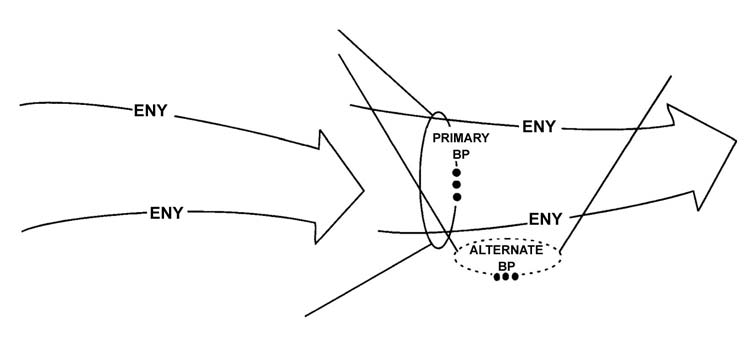
FM 3-21.11
fields of fire to allow mutual support. If the terrain or the expected enemy course of action prevents this, the defense may be more effective if control is more decentralized and the platoons fight in sector.
(3) A significant concern, particularly when fighting from BPs, is the enemy's ability to isolate a part of the company and then fix and destroy or bypass them. Without effective mutual support between the BPs, this is likely to occur. Even with mutual support, responsive and effective indirect fire support may be critical to defending the BPs. Without immediately available fire support, a capable enemy will quickly concentrate combat power against any BP that is identified.
5-21. BATTLE
POSITION
DEFENSE
A battle position is a general location and orientation of forces on the ground from which units defend. The platoon is located within the general area of the BP. Security elements may be located forward and to the flanks of the BP. Platoons defending a BP may not be tied in with adjacent units; thus, the requirement for all-round security is increased. When assigning BPs, the commander assigns his platoons sectors of fire and primary positions to defend. Each position must contribute to the company's accomplishment of its assigned task and purpose within the battalion commander's concept of the operation. A commander also may assign alternate and supplementary positions to platoons, depending on the situation.
a. Alternate Position. An alternate position is a position to the front, flank, or slightly to the rear of the primary position (Figure 5-3). It must allow the platoon to cover the same sector of fire as the primary position. If it is to be occupied during limited visibility, it may be forward of the primary position. The alternate position may be occupied if the platoon is driven out of the primary position by enemy fire or by assault, or it may be occupied to begin the fight to deceive the enemy of the platoon's primary position.
Figure 5-3. Alternate position.
b. Supplementary Position. A supplementary position is to the flank or the rear of the primary position. It allows the platoon to defend against an attack on an avenue of approach not covered by the primary position (Figure 5-4). It can be assigned when the platoon must cover more than one avenue of approach. A platoon moves from its 5-16
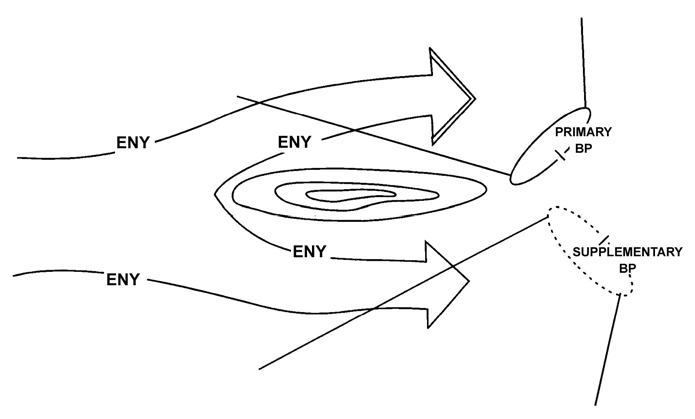
FM 3-21.11
primary, alternate, or supplementary position only with the commander's approval or when a condition exists that the commander has prescribed as a reason to move.
Figure 5-4. Supplementary position.
c. Centralized Technique. Fighting from battle positions is a more centralized technique and also may be more linear at the company level (Figure 5-5, page 5-18).
Even so, it should not be a static defense. Battle positions should be positioned to achieve surprise and to allow maneuver within and between BPs. Defense from BPs is effective in concentrating combat power into an engagement area. It prevents the enemy from isolating one part of the company and concentrating his combat power in this area.
Normally, platoons are assigned mutual supporting battle positions that cover the enemy's likely avenue of approach. These BPs are located on terrain that provides cover and concealment and restricts vehicular movement.
d. Achieving Surprise. The commander's concept for fighting this defensive technique should concentrate on achieving surprise for each of the BPs. This is accomplished by conducting an effective counterreconnaissance effort to prevent the enemy from locating the BPs and by initiating fires from one BP and waiting for the enemy to react to this engagement prior to engaging from the other BPs (Figure 5-5, page 5-18). Fighting in this manner confuses the enemy and disrupts his C2 process.
5-17
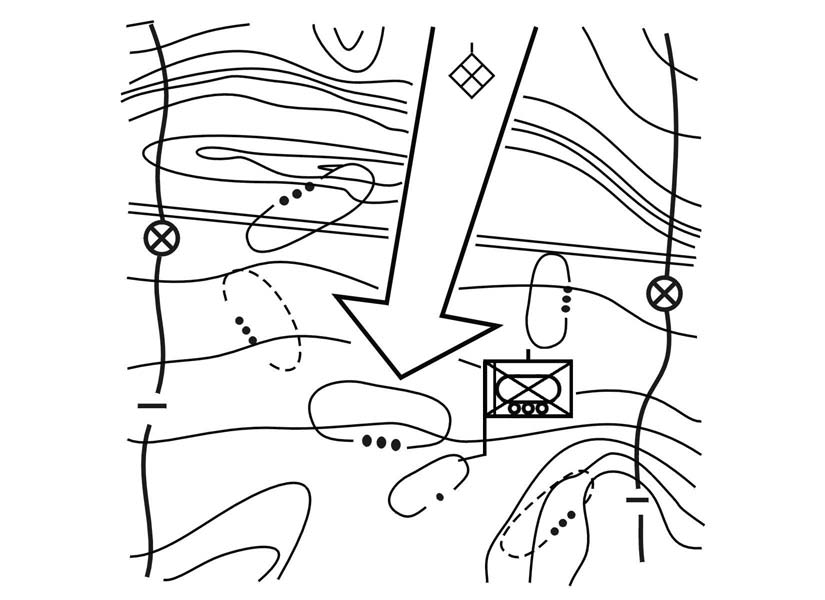
FM 3-21.11
Figure 5-5. Defense from mutually supporting platoon battle positions.
(5) When the terrain provides a large EA and the commander's concept allows most of the enemy into the EA, the company may engage with massed fires from all platoon BPs. A disadvantage to this technique is that if there are still uncommitted enemy forces outside the EA, they will know the locations of the BPs and will attempt to isolate and concentrate against them. Contingency plans to disengage from these BPs and reorganize to continue the fight must be developed. This may involve displacing to alternate BPs or disengaging to conduct counterattacks or spoiling attacks against identified enemy C2, CS, or CSS assets.
(6) Instead of one company EA, multiple EAs may be identified to provide flexibility to the plan (Figure 5-6). The plan must clearly state which platoons must reorient fires into the alternate engagement area and when they must do so.
5-18
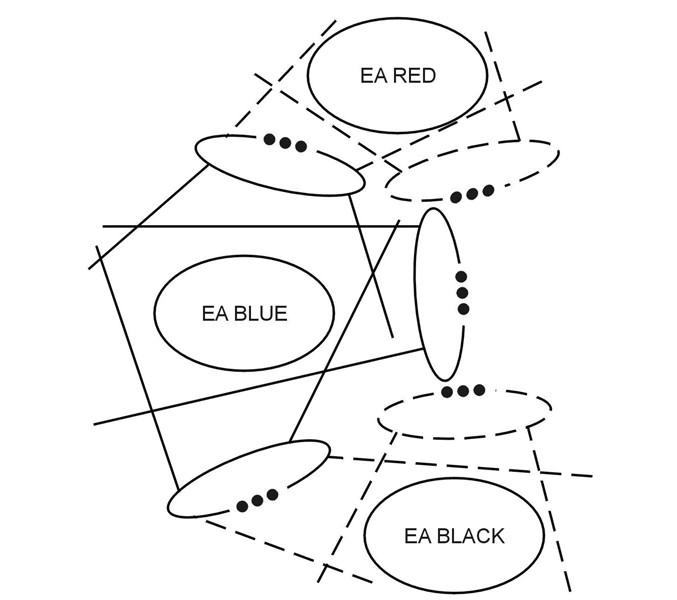
FM 3-21.11
Figure 5-6. Multiple engagement areas.
5-22. STRONGPOINT
DEFENSE.
A company may be directed to construct a strongpoint as part of a larger SBCT infantry battalion defense (Figure 5-7, page 5-20). In order to do so, it must be augmented with engineer support, more weapons, and CSS resources. A strongpoint is defended until the commander directing the defense formally orders the unit out of it.
a. The specific positioning of units in the strongpoint depends on the company commander’s mission analysis. The same considerations for a perimeter defense apply, in addition to the following:
(1)
Reinforce each individual fighting position (to include alternate and supplementary positions) to withstand small-arms fire, mortar fire, and artillery fragmentation. Stockpile food, water, ammunition, pioneer tools, and medical supplies in each fighting position.
(2) Support each individual fighting position with several others. Plan or construct covered and concealed routes between positions and along routes of supply and communication. Use these to support counterattack and maneuver within the strongpoint.
5-19
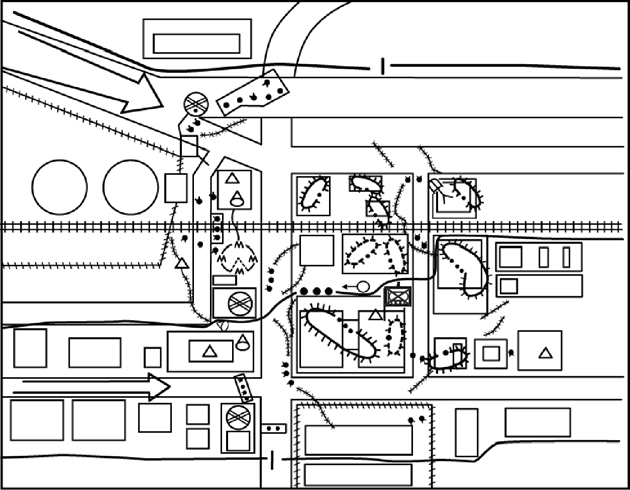
FM 3-21.11
Figure 5-7. Company strongpoint.
(3) Divide the strongpoint into several independent, but mutually supporting, positions or sectors. If one of the positions or sectors must be evacuated or is overrun, limit the enemy penetration with obstacles and fires and support a counterattack.
(4) Construct obstacles and minefields to disrupt and canalize enemy formations, to reinforce fires, and to protect the strongpoint from the assault. Place the obstacles and mines out as far as friendly units can observe them, within the strongpoint, and at points in between where they will be useful.
(5) Prepare range cards for each position and confirm them by fires. Plan indirect fires in detail and register them. Also plan indirect fires for firing directly on the strongpoint using proximity fuses.
(6) Plan and test several means of communication within the strongpoint and to higher headquarters. Possibilities include radio, wire, messenger, pyrotechnics, and other signals.
(7) Improve or repair the strongpoint until the unit is relieved or withdrawn. More positions can be built, tunnels and trenches dug, existing positions improved or repaired, and barriers built or fixed.
b. A strongpoint may be part of any defensive plan. It may be built to protect vital units or installations, as an anchor around which more mobile units maneuver, or as part of a trap designed to destroy enemy forces that attack it.
c. Mold the strongpoint to the terrain and use natural camouflage and obstacles.
Existing obstacles can support formidable strongpoints, providing cover, concealment, and obstacles. Complex and urban areas are also easily converted to strongpoints. Stone, brick, or steel buildings provide cover and concealment. Buildings, sewers, and some streets provide covered and concealed routes and can be rubbled to provide obstacles.
Telephone systems can provide communications.
5-20
FM 3-21.11
5-23. PERIMETER
DEFENSE
A perimeter defense allows the defending force to orient in all directions (Figure 5-8). In terms of weapons emplacement, direct and indirect fire integration, and reserve employment, a commander conducting a perimeter defense must consider the same factors as for a strongpoint operation. The SBCT infantry rifle company may be called upon to execute this type of defense under a variety of conditions, including the following:
• When it must hold critical terrain in areas where the defense is not tied in with adjacent units.
• When it has been bypassed and isolated by the enemy and must defend in place.
• When it conducts occupation of an independent assembly area or reserve position.
• When it begins preparation of a strongpoint.
• When it is directed to concentrate fires into two or more adjacent avenues of approach.
a. Preparations. The SBCT infantry company prepares a perimeter defense when there are no friendly units adjacent to it (Figure 5-8, page 5-22). A perimeter defense may be used in a reserve position, in an assembly area or patrol base, on a follow-on decentralized company operation, during resupply, or when the company is isolated. The following actions constitute setting up a perimeter defense:
5-21
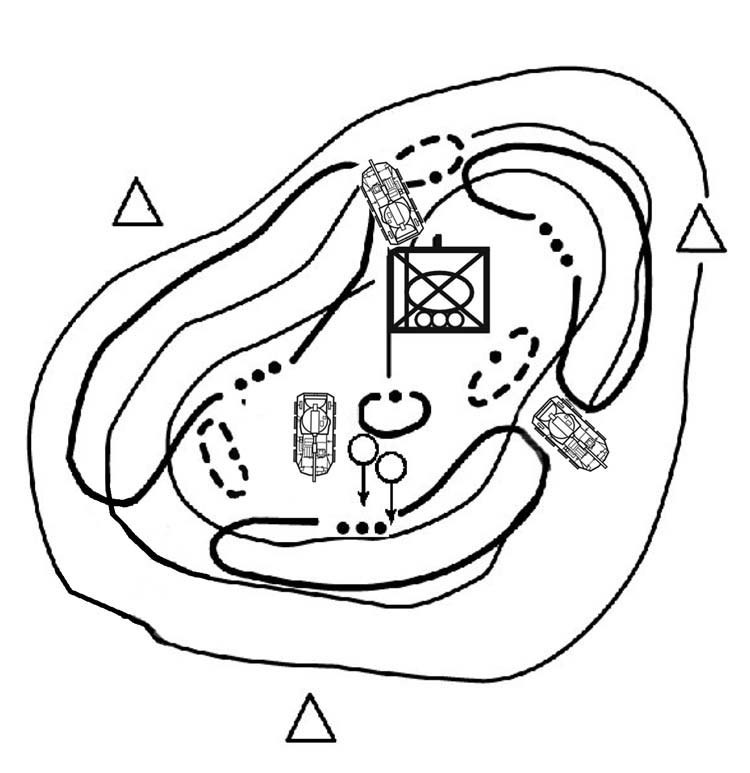
FM 3-21.11
Figure 5-8. Company perimeter defense.
(1) Preparing a perimeter defense is like preparing any other position defense, but the company must disperse in a circular configuration for all-round security (the actual shape depends on the terrain). The company must be prepared to defend in all directions.
(2) The commander assigns the infantry platoon covering the most likely approach a smaller sector than the other platoons. He prepares alternate and supplementary positions within the perimeter.
(3)
If
available,
Javelins and MGS vehicles cover likely armor approaches. They may
use hide positions and move forward to fire as the enemy appears. The commander should assign several firing positions to Javelins and MGS vehicles. If there are few positions for them, they are assigned a primary position and are dug in.
(4) Keep the mortars near the center of the perimeter so their minimum range (70
meters) does not restrict their ability to fire in any direction. They should be dug in and have covered ammunition storage bunkers. They communicate by phone (the wire is buried). The fire direction center (FDC) is dug in with overhead cover.
(5) If possible, hold at least one mounted rifle squad in reserve. The company commander assigns a primary position to the rear of the platoon, covering the most 5-22
FM 3-21.11
dangerous avenue of approach. He also may assign the rifle squad supplementary positions since it must be prepared to fight in all directions.
(6) Prepare obstacles in depth around the perimeter.
(7) Plan direct and indirect fire as for any type of defense. Plan and use fire support from outside the perimeter when available.
(8) Counter enemy probing attacks by area fire weapons (artillery, mortars, Claymores, and grenade launchers) to avoid revealing the locations of fighting positions.
(9) If the enemy penetrates the perimeter, the reserve blocks the penetration and covers friendly soldiers while they move to their alternate or supplementary positions.
Even though the company's counterattack ability is limited, it must strive to restore its perimeter.
(10) CSS elements may support from within the perimeter or from another position.
Supply and evacuation may be by air. Consider the availability of landing zones and drop zones (protected from enemy observation and fire) when selecting and preparing the position.
b. Y Variation. The Y-shaped perimeter defense is a variation of the perimeter defense that uses the terrain effectively. This defense is used when the terrain, cover and concealment, or the fields of fire do not support the physical positioning of the platoons in a circular manner. The Y-shaped perimeter defense (Figure 5-9, page 5-24) is so named because the platoon battle positions are positioned on three different axes radiating from one central point. It is still a perimeter defense because it is effective against an attack from any direction. The Y-shaped defense provides all-round perimeter fires without having to position soldiers on the perimeter. It is most likely to be effective in mountainous terrain, but it also may be effective in a dense jungle environment due to limited fields of fire. All of the fundamentals of a perimeter defense previously discussed apply, with the following adjustments and special considerations:
(1) Although each platoon battle position has a primary orientation for its fires, each platoon must be prepared to reorient to mass fires into the EAs to its rear.
(2) When no most likely enemy approach is identified, or during limited visibility, each platoon may have half its soldiers oriented into the EAs to the front and half into the EAs to the rear. Ideally, supplementary individual fighting positions are prepared to allow the soldiers to reposition when required to mass fires into one EA.
5-23
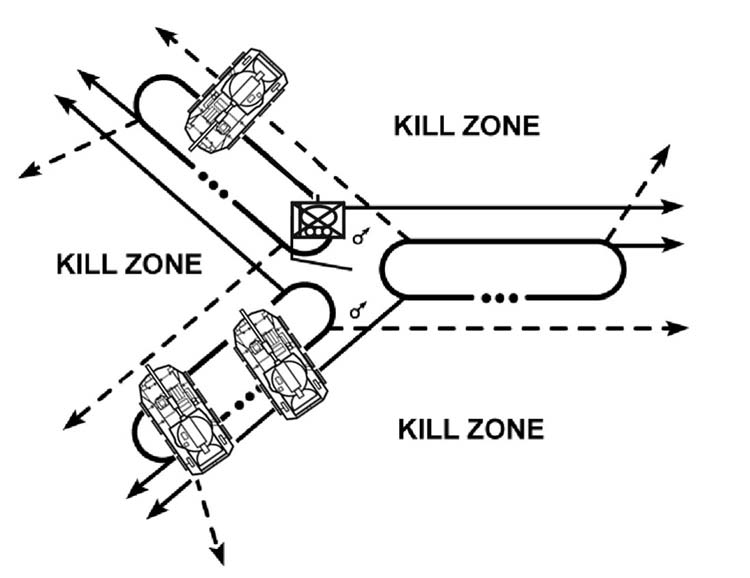
FM 3-21.11
Figure 5-9. Y-shaped perimeter defense.
(3) When a most likely enemy avenue of approach is identified, the company commander may adjust the normal platoon orientations to concentrate fires (Figure 5-10).
This entails accepting risk in another area of the perimeter. The company security plan should compensate for this with additional OPs, patrols, or other measures.
(4) The positioning of the company CP, mortars, a reserve, or any CSS assets is much more difficult due to a lack of depth within the perimeter.
5-24
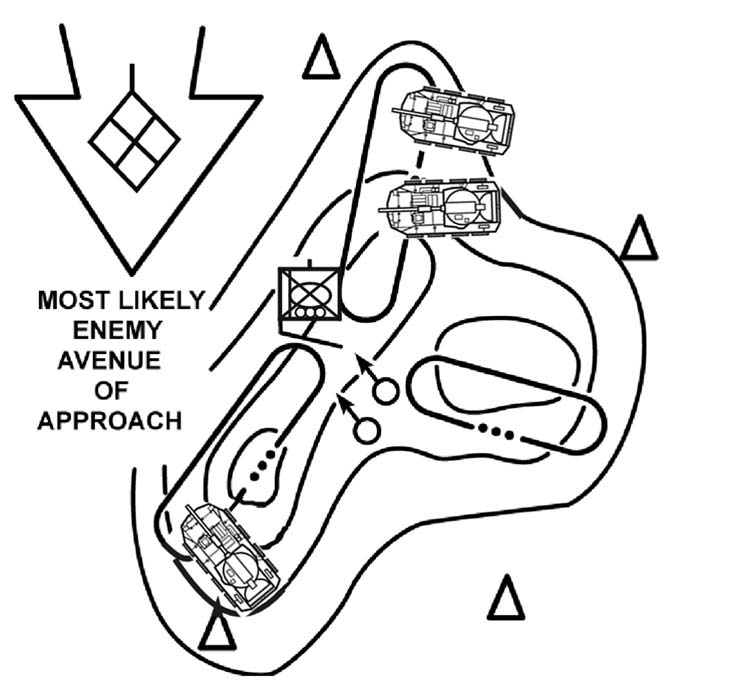
FM 3-21.11
Figure 5-10. Modified Y-shaped perimeter defense.
(5) The most difficult aspect of the Y-shaped perimeter defense is the fire control measures required. To safely fight this defense without casualties from friendly fire, the leaders must ensure the limits of fire for each weapon do not allow fires into the adjacent platoon position. In a mountainous environment, firing downward into the EAs may make this more simple. Some measures to consider include:
• Position machine guns near the apex of the Y to allow an FPL that covers the platoon front while firing away from the adjacent platoon.













